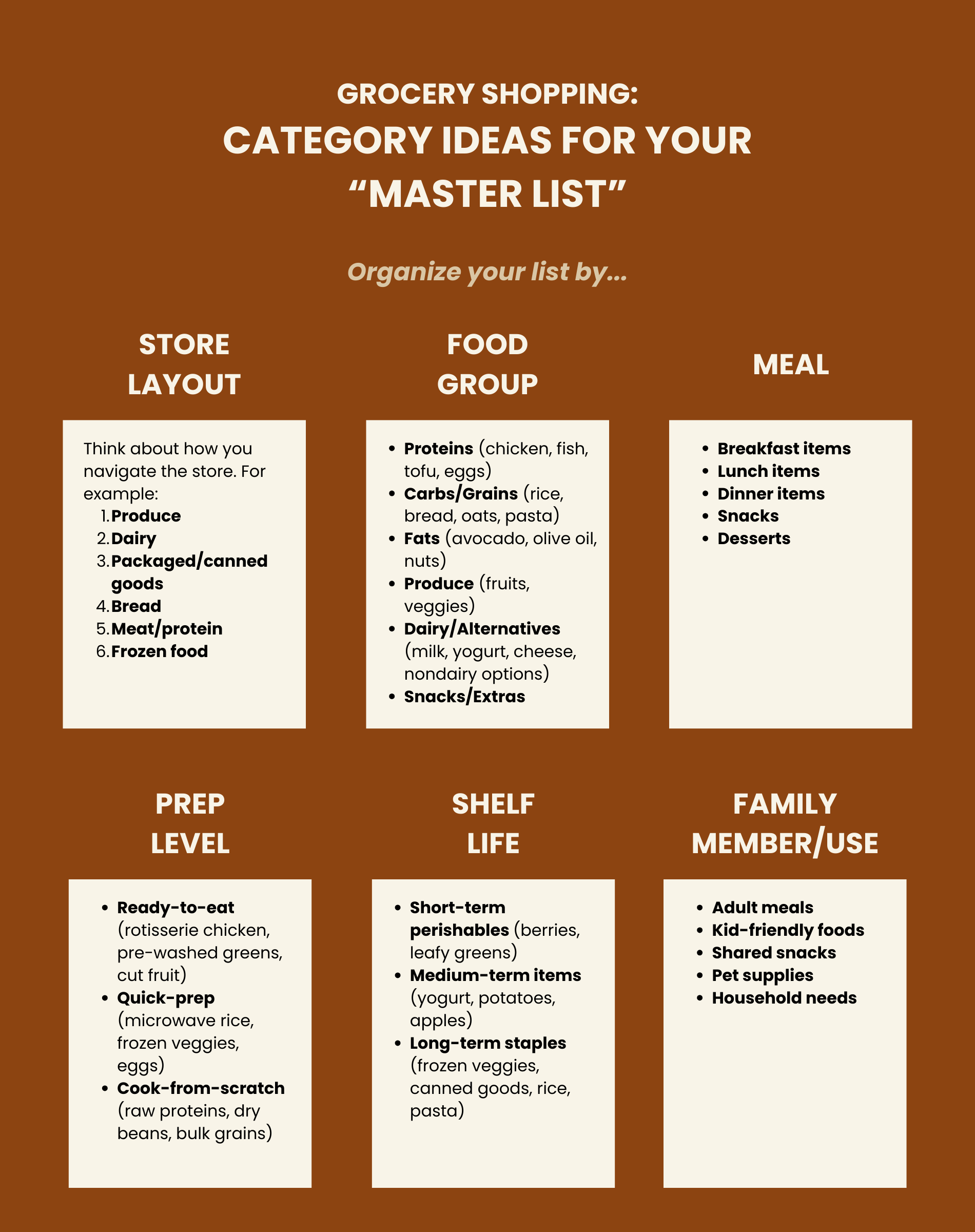HOW TO GROCERY SHOP EFFICIENTLY
School is starting, schedules are filling up, and if you’re anything like me (and I’m not unique here!), grocery shopping can quickly become one more decision-heavy task that drains your brain. Between remembering what you have at home, figuring out what to make, and trying to navigate crowded aisles — decision fatigue can hit hard before you even get to checkout.
My take: with a system in place, grocery shopping doesn’t have to be stressful or time-consuming. In fact, you can walk in (or click “checkout” for pickup/delivery) with confidence, knowing you’ve already done the heavy mental lifting.
STEP 1: BUILD YOUR “MASTER LIST”
Instead of writing a new grocery list from scratch every week, create a running list of staple foods you buy regularly.
Break it into categories that make sense to you and the way you prepare your list, shop for groceries, and create meals. That might look like by store layout, food group, by meal or prep level, or even by shelf life or family members and uses.
Keep it somewhere you can easily add to — like a note on your phone, a Google doc, or a list-making app (depending of if you are collaborating on the list with others).
When you plan your weekly meals, simply highlight or check off the items you need.
This means you’re not reinventing the wheel every single week — you’re starting with a streamlined foundation.
STEP 2: PLAN AROUND YOUR SCHEDULE, NOT JUST YOUR RECIPES
We often start our thinking around grocery lists and food prep with asking ourselves and families, “What do I/we feel like making (and/or eating) this week?” (If you don’t *feel like* making anything, this can be a challenging question to try and answer!) Instead, ask:
Which nights will be busy? (Those get quick, low-prep meals or leftovers.)
When do I have more time to cook? (That’s when I can cook a meal that has different components or try a new recipe.)
Match your grocery list to your real-life schedule. For example, if you know you’ve got a bunch of deadlines that are going to consume your mental load and have you working later or know you’ll be running kids to practice three nights this week, make sure you have easy wins on hand — ex. rotisserie chicken, steamable veggies, pre-cooked rice. Leaning on convenience options isn’t cheating, it’s playing the game a smarter-not-harder way.
STEP 3: SHOP YOUR KITCHEN FIRST
Before heading to the store, do a quick sweep of your fridge, freezer, and pantry. Audit what you’ve got at home first to:
Check expiration dates and use what’s close to going bad.
Take inventory of proteins, produce, and grains you already have so you don’t double-buy. This keeps your list focused and reduces food waste – and you might even notice that you’ve got enough on hand to save you from planning, shopping, and prepping a meal or two!
STEP 4: WALK THE STORE IN THE SAME PATTERN EACH TIME YOU SHOP
If you shop in person, follow the same path each time you go to the grocery store. (This is why I’m a huge fan of organizing your grocery list by store layout!) You’ll more than likely start with produce (that’s where most entrances are) and then move on from there – every grocery store is laid out differently! But, by following a similar pattern each time, you build muscle memory for where items are located, and this eliminates zig-zagging around the store (helping you get in and out faster).
If you order online steps 1-3 remain the same, but instead of walking the same path at the store, save your previous carts or “favorite” your go-to items so you can reorder in minutes.
STEP 5: KEEP A BACK-UP MEAL PLAN
Sometimes life happens and the organized, thoughtful plan you created goes some-of-the-way or all-the-way out the window. Keep a few “emergency” meals stocked—things you can throw together in 15 minutes or less. Think:
Frozen salmon burgers + bagged salad or frozen veggies
Canned tuna + crackers + fruit
Scrambled eggs + toast + veggies
This takes the pressure off if you miss a shopping trip or need to delay it by a day or two. (A tip: when you use one of these “emergency” meals, put it back on your list immediately. This way, it’ll be re-purchased and waiting for you again when you need to rely on it!)
Grocery shopping doesn’t have to be a mental marathon with a little bit of planning. Build a reusable list, plan for your actual life, shop your kitchen first, and keep a couple of back-pocket meals in mind. That way, when you hit the store (or your online cart), you’re not starting from scratch — you’re simply running the play you already designed.
Looking for support to make some of these shifts? Nutrition coaching can help with giving you some extra guidance. (And applying doesn’t have to feel scary – filling out this form puts us in touch so that we can have a (free!) conversation and get to know each other to make sure we’re a great coach/client fit!)

